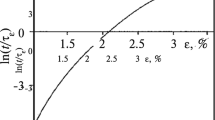Consideration of the issues of improving the accuracy of digital prediction of the deformation modes of operation of polymer textile materials, which are important both from the scientific and research side and from the practical side, allows deriving recommendations for the creation of new promising materials with specified functional properties. A method for optimizing mathematical simulation of the fundamental operation modes of polymer textile materials is also considered.


Similar content being viewed by others
References
M. A. Egorova, I. M. Egorov, et. al., “Mathematical simulation and prediction of deformation processes in nonwoven materials,” Dizain Mater. Tekhnol., No. 4, 119-126 (2021).
M. A. Egorova, I. M. Egorov, and A. A. Kozlov, “Computer prediction and analysis of functional properties of synthetic textile materials,” Khim. Volokna, No. 3, 11-14 (2021).
V. I. Vagner, A. A. Kozlov, et al., “Systematic analysis of viscoelastic-plastic properties of marine polymer ropes,” Khim. Volokna, No. 3, 69-72 (2021).
N. V. Pereborova, “Methodology of computer simulation of deformation-relaxation processes of polymer textile materials,” Vest. SPGUTD. Ser. 1. Estest. Tekhn. Nauki, No. 2, 33-42 (2017).
N. V. Pereborova, “Increasing the competitiveness of aramid textile materials based on qualitative analysis of their operational-deformation properties,” Vest. SPGUTD. Ser. 1. Estest. Tekhn. Nauki, No. 4, 123-132 (2017).
A. A. Kozlov, M. A. Egorova, and I. M. Egorov, “Prediction of creep of synthetic protective clothing materials,” Khim. Volokna, No. 3, 16-18 (2021).
S. V. Kiselev, A. A. Kozlov, et. al., “Variant of mathematical modelling of deformation propertie of textile polymer materials,” Izv. VUZ. Tekhnol. Legk. Promysh., 53, No. 3, 96-102 (2021).
N. V. Pereborova, E. A. Ananichev, I. A. Antonova, et al., “Methodology for modelling and computer forecasting the deformation-operational properties of polymer textile materials,” Izv. VUZ. Tekhnol. Legk. Promysh., 43, No. 1, 136-145 (2019).
A. A. Kozlov, N. S. Klimova, et. al., “System analysis of deformation properties of polymer textile materials based on mathematical modelling of viscoelasticity,” Izv. VUZ. Tekhnol. Legk. Promysh., 53, No. 3, 62-57 (2021).
S. V. Kiselev, A. A. Kozlov, et. al. “Methods for simulating elastic properties of twisted polyester threads,” Dizain Mater. Tekhnol., No. 3, 120-126 (2021).
V. V. Golovina, P. P. Rymkevich, and V. I. Vagner, “Application of nonlinear rheological models to the description and explanation of the nonclassical behaviour of longitudinal free low-amplitude oscillations in polymer filaments,” Izv. VUZ. Tekhnol. Legk. Promysh., 55, No. 1, 13-18 (2022).
A. A. Romanova, P. P. Rymkevich, et. al., “Relaxing Young modulus of synthetic threads,” Izv. VUZ. Tekhnol. Tekstil. Promysh., No. 4 (299), 3-5 (2007).
The research was financed under the grant of the President of the Russian Federation No. NSh-5349.2022.4
Author information
Authors and Affiliations
Corresponding author
Additional information
Translated from Khimicheskie Volokna, No. 5, pp. 53-57, September-October, 2022.
Rights and permissions
Springer Nature or its licensor (e.g. a society or other partner) holds exclusive rights to this article under a publishing agreement with the author(s) or other rightsholder(s); author self-archiving of the accepted manuscript version of this article is solely governed by the terms of such publishing agreement and applicable law.
About this article
Cite this article
Makarov, A.G. Improving the Accuracy of Digital Prediction of Deformation Modes of Operation of Polymer Textile Materials. Fibre Chem 54, 328–332 (2023). https://doi.org/10.1007/s10692-023-10402-0
Published:
Issue Date:
DOI: https://doi.org/10.1007/s10692-023-10402-0



